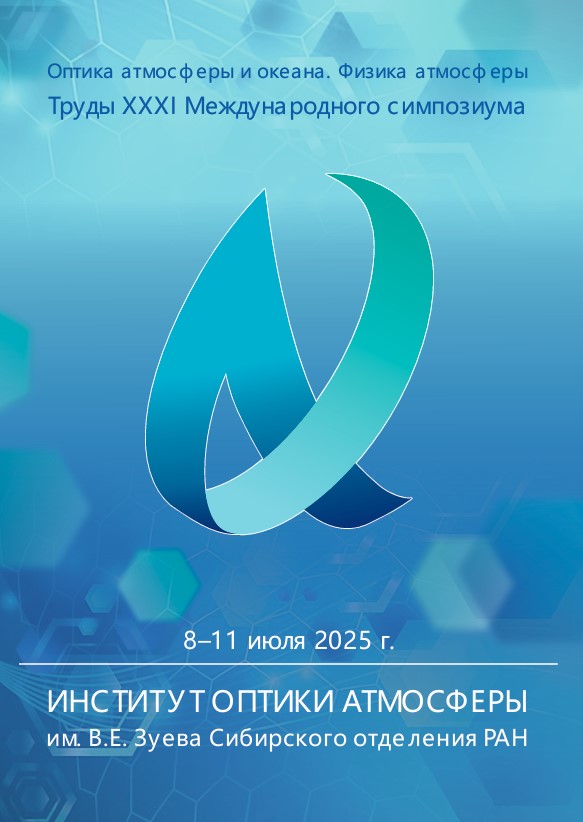Institut optiki atmosfery im. V.E. Zueva SO RAN
Institut monitoringa klimaticheskih i ekologicheskih sistem SO RAN
UDC 535.8
CSCSTI 29.31
Russian Classification of Professions by Education 03.04.02
Russian Library and Bibliographic Classification 223
Russian Trade and Bibliographic Classification 613
BISAC SCI053000 Physics / Optics & Light
High-level clouds significantly affect the climate by regulating radiation fluxes in the atmosphere. However, their microstructure in atmospheric models is taken into account in a simplified manner, which leads to calculation errors and errors in weather and climate forecasts. Stable existing for longer than 10 minutes contrails and cirrus formed from them are the only type of artificial crystalline clouds. Contrails are studied based on the polarization laser sensing method. To assess their effect on the propagation of solar radiation in the atmosphere, data on the spectral radiance measured by the MODIS satellite spectroradiometer were used. The combined use of lidar measurements and satellite observations allows the SR dynamics to be estimated as a function of the temporal evolution of contrails.
atmosphere, lidar, clouds.
1. Gayet J.F., Febvre G., Brogniez G., et al. Microphysical and optical properties of cirrus and contrails: Cloud field study on 13 October 1989 // J. Atmos. Sci. 1996. V. 53, № 1. P. 126–138.
2. Bock L., Burkhardt U. The temporal evolution of a long–lived contrail cirrus cluster: Simulations with a global climate model // J. Geophys. Res.: Atmosphere. 2016. V. 121, № 7. P. 3548–3565.
3. Wang Z., Bugliaro L., Jurkat-Witschas T., et al. Observations of microphysical properties and radiative effects of a contrail cirrus outbreak over the North Atlantic // Atmos. Chem. Phys. 2023. V. 23. P. 1941–1961.
4. Minnis P., Ayers J.K., Palikonda R., et al. Contrails, Cirrus Trends, and Climate // J. Clim. 2004. V. 17, № 8. P. 1671–1685.
5. Minnis P., Young D.F., Garber D.P., et al. Formation and radiative forcing of contrail cirrus // Nature communications. 2018. V. 9. Article No. 1824.
6. Kaul' B.V. Optiko-lokacionnyy metod polyarizacionnyh issledovaniy anizatropnyh aerozol'nyh sred: dis. dokt. fiz.-mat. nauk. Tomsk, 2004. 219 s.
7. University of Wyoming [Elektronnyy resurs]. URL: http://weather.uwyo.edu (data obrascheniya: 10 aprelya 2025 g.).
8. Copernicus Climate Data Store [Elektronnyy resurs]. URL: https://cds.climate.copernicus.eu (data obrascheniya: 5 aprelya 2025 g.).
9. Flightradar24. Live Air Traffic [Elektronnyy resurs]. URL: https://www.flightradar24.com (data obrascheniya: 1 aprelya 2025 g.).
10. Bryukhanov I., Loktyushin O., Ni E., et al. Comparison of the Contrail Drift Parameters Calculated Based on the Radiosonde Observation and ERA5 Reanalysis Data // Atmosphere. 2024. V. 15. 1487.
11. Justice C.O., Townshend J.R.G, Vermote E.F., et al. An overview of MODIS Land data processing and product status // Rem. Sens. Env. 2002. V. 83, № 1–2. P. Pages 3–15.
12. Samohvalov I.V., Loktyushin O.Yu. Bryuhanov I.D. i dr. Sovmestnaya obrabotka rezul'tatov lazernogo polyarizacionnogo zondirovaniya oblakov verhnego yarusa s dannymi sputnikovogo spektroradiometra MODIS // Elektronika, fotonika i kiberfizicheskie sistemy. 2024. T. 4, № 1. S. 26–33.
13. Rizvi A.A., Addoweesh K., El-Leathy A., et al. Sun position algorithm for sun tracking applications // IECON 2014 – 40th Annual Conference of the IEEE Industrial Electronics Society. Dallas, TX, USA. October 29 – November 1, 2014. P. 5595–5598.
14. Bryuhanov I.D. Opticheskie svoystva oblakov verhnego yarusa estestvennogo i antropogennogo proishozhdeniya, soderzhaschih orientirovannye kristally l'da, po dannym polyarizacionnogo lazernogo zondirovaniya: dis. kand. fiz.-mat. nauk. Tomsk, 2022. 138 s





